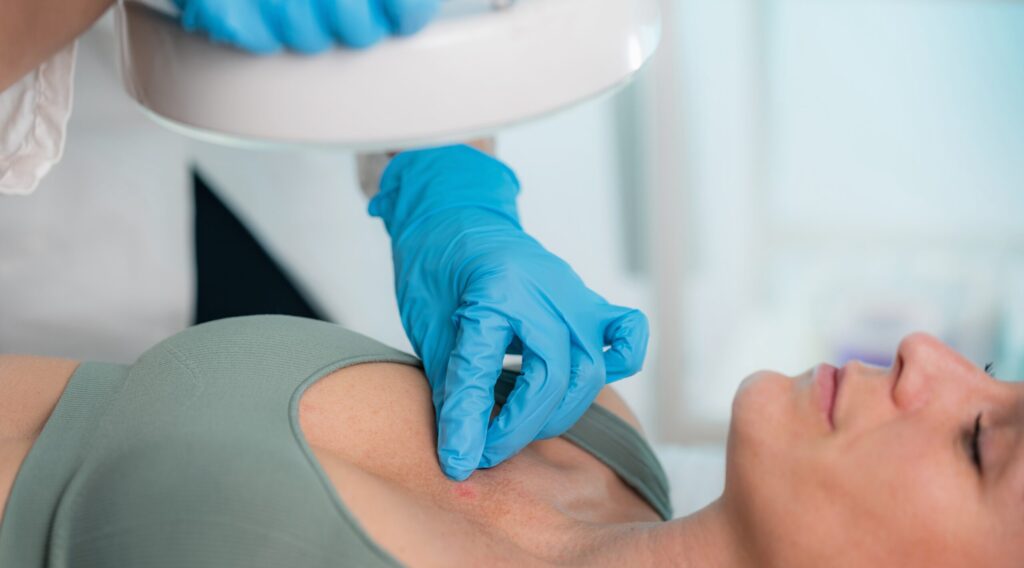Introduction
Actinic keratosis (AK) is a common skin condition that predominantly affects individuals with fair skin who have had significant sun exposure. Often considered a precancerous condition, AK can progress to squamous cell carcinoma (SCC) if left untreated. This blog will provide a comprehensive overview of actinic keratosis, including its causes, diagnosis, prognosis, treatment options, and management strategies to prevent further disease or progression.
What is Actinic Keratosis?
Actinic keratosis is a rough, scaly patch on the skin that develops from years of exposure to the sun. It is considered a precancerous lesion because it has the potential to turn into squamous cell carcinoma, a type of skin cancer.
How Does Actinic Keratosis Present?
How It Occurs
Actinic keratosis occurs when skin cells (keratinocytes) are damaged by ultraviolet (UV) radiation from the sun or tanning beds. This damage accumulates over time, leading to changes in the skin cells that result in AK.
When It Occurs
- Age: AK is more common in older adults because it takes years of sun exposure for these lesions to develop. People over the age of 40 are at higher risk.
- Seasons: While AK can appear at any time, it is more likely to be noticed in the summer months when the skin is exposed to more sunlight.
Where It Occurs
AK commonly appears on sun-exposed areas of the body, such as:
- Face
- Ears
- Scalp (particularly in bald individuals)
- Neck
- Backs of the hands
- Forearms
- Shoulders
Causes of Actinic Keratosis
The primary cause of actinic keratosis is prolonged exposure to UV radiation from the sun or tanning beds. Factors that increase the risk of developing AK include:
- Fair Skin: Individuals with light skin, hair, and eyes are more susceptible.
- History of Sunburns: Frequent or severe sunburns, especially during childhood.
- Geographic Location: Living in sunny or high-altitude regions.
- Outdoor Activities: Spending a lot of time outdoors for work or recreation.
- Weakened Immune System: Conditions or medications that suppress the immune system.
Diagnosis of Actinic Keratosis
Clinical Examination
A dermatologist typically diagnoses AK through a physical examination of the skin. The appearance of rough, scaly patches on sun-exposed areas is often sufficient for a diagnosis. These skin lesions are often better felt than seen. Skin affected by actinic keratosis often feel gritty, like sandpaper, compared to unaffected areas.
Skin Biopsy
In some cases, if the diagnosis is uncertain or if there is suspicion of progression to squamous cell carcinoma, a skin biopsy may be performed. This involves taking a small sample of the affected skin for laboratory analysis.
Prognosis of Actinic Keratosis
The prognosis for actinic keratosis is generally good, especially with early detection and treatment. However, the main concern with AK is its potential to develop into squamous cell carcinoma. Approximately 5-10% of actinic keratoses can progress to SCC, making regular monitoring and treatment essential.
The primary concern with actinic keratosis is its potential to progress to squamous cell carcinoma, a more serious form of skin cancer. SCC can invade deeper layers of the skin and spread to other parts of the body if not treated promptly.
Treatment Options
Many of the treatment options available for actinic keratosis are the same as those approved for the treatment of skin cancer. The main differences are the dosage and manner in which these treatments are delivered.
Topical Treatments
- 5-Fluorouracil (5-FU): A chemotherapy cream that destroys precancerous cells.
- Imiquimod: An immune response modifier that helps the body eliminate abnormal cells.
- Diclofenac: A nonsteroidal anti-inflammatory gel that treats AK.
- Tirbanibulin: A topical microtubule inhibitor that disrupts cellular proliferation and is used to treat actinic keratosis.
Procedural Treatments
- Cryotherapy: Freezing the lesion with liquid nitrogen to destroy abnormal cells.
- Curettage and Electrosurgery: Scraping away the lesion followed by the application of electric current to destroy remaining cells.
- Photodynamic Therapy (PDT): Applying a photosensitizing agent to the skin followed by exposure to a specific wavelength of light to destroy abnormal cells.
- Laser Therapy: Using laser energy to remove the lesion.
Surgical Removal
In cases where there is a high suspicion of progression to SCC or for larger, thicker lesions, surgical excision may be performed to remove the affected tissue completely.
Preventing Further Disease or Progression
Regular Dermatologic Check-Ups
Patients with actinic keratosis should have regular skin examinations by a dermatologist to monitor existing lesions and identify new ones early.
Sun Protection
- Use Sunscreen: Apply a broad-spectrum sunscreen with an SPF of 30 or higher daily.
- Wear Protective Clothing: Use hats, long sleeves, and sunglasses to cover sun-exposed skin.
- Seek Shade: Avoid direct sun exposure, especially during peak hours (10 a.m. to 4 p.m.).
Self-Examinations
Perform regular self-examinations to check for new or changing skin lesions. Report any suspicious changes to a dermatologist promptly.
Avoid Tanning Beds
Refrain from using tanning beds, as they emit harmful UV radiation that can increase the risk of skin damage and AK.
Conclusion
Actinic keratosis is a common but potentially serious skin condition caused by prolonged exposure to UV radiation. Early diagnosis and treatment are crucial to prevent progression to squamous cell carcinoma. Various treatment options are available, ranging from topical treatments to surgical procedures. Regular monitoring and adopting sun protection measures are essential for managing AK and reducing the risk of further skin damage or cancer development. If you have actinic keratosis or are at risk, consult with Dr. Mamelak for personalized advice and treatment options.
—
Dr. Adam Mamelak is a Canadian and American Board-Certified Dermatologist and Mohs Micrographic Surgeon that specializes in the treatment of skin cancer patients in Austin, Texas.


